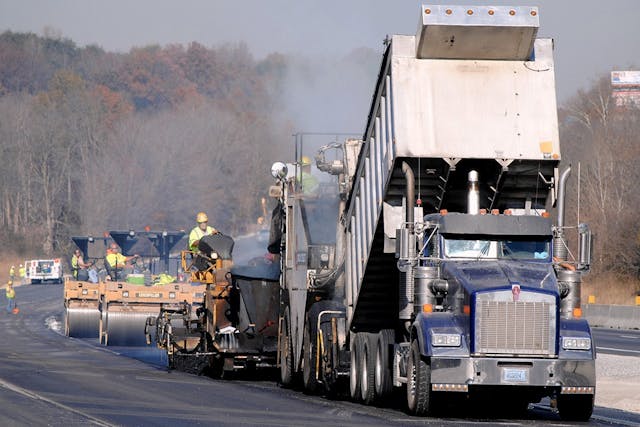Hot Mix Asphalt: The Foundation for Safe and Secure Angled Parking Lots
Hot Mix Asphalt: The Foundation for Safe and Secure Angled Parking Lots
Blog Article
Opening the Secrets of Warm Mix Asphalt Technology
Discovering the depths of warm mix asphalt modern technology discovers a world where meticulous processes and exact formulas assemble to form our roads and facilities. The blend of aggregates, fillers, and binders isn't merely a building and construction task yet a calculated orchestration of durability and performance. As we peer right into the complex dance of components, a tapestry of resilience and sustainability unravels. However what exists under this surface area of asphaltic mastery, and what keys wait to be introduced in the world of paving advancements?
Value of Warm Mix Asphalt
Hot Mix Asphalt plays a critical role in contemporary facilities growth due to its sturdiness and cost-effectiveness. As the most typically made use of paving material for roadways, highways, and car park great deals, Hot Mix Asphalt offers a variety of advantages that add to its value in construction jobs.
The durability of Warm Mix Asphalt originates from its make-up, which consists of aggregates, binder, and filler materials that are very carefully chosen and blended to satisfy specific performance needs. This accurate combination leads to a strong and flexible pavement that can sustain regular use without substantial damage. Moreover, Hot Mix Asphalt is 100% recyclable, additional improving its sustainability and environmental benefits. On the whole, the importance of Warm Mix Asphalt in facilities advancement can not be underrated, as it remains to be a foundation of modern-day building and construction methods.
Components of Asphalt Mixes
The composition of asphalt blends consists of thoroughly chosen accumulations, binder, and filler products that are crucial for attaining particular efficiency needs. Aggregates are the key component of asphalt mixes, giving toughness and security. The binder, normally bitumen or asphalt cement, holds the accumulations with each other and gives flexibility and durability to the mix.
The mix and percentage of these components play a considerable role in establishing the quality and performance of the asphalt mix. Engineers very carefully design the mix to meet details requirements, considering aspects like web traffic volume, climate problems, and pavement life-span. Appropriate choice and harmonizing of aggregates, binder, and fillers are vital for developing long lasting, resilient asphalt pavements.
Mixing and Manufacturing Techniques

Once the accumulations are picked, the binder, commonly asphalt cement, is contributed to bind the materials with each other. The binder's top quality and amount considerably impact the mix's versatility, resistance, and strength to ecological aspects. In addition, fillers like hydrated lime or Rose city concrete might be integrated to boost details characteristics of the asphalt mix, such as its workability or moisture resistance.
Throughout production, the accumulations and binder are heated, typically between 250-325 ° F(121-163 ° C ), to assist in blending and make sure proper finishing of the aggregates. The mixing process must be detailed to attain a homogeneous mixture that promotes the preferred performance qualities of the asphalt. Numerous techniques, such as set blending or drum mixing, are employed to achieve high-quality and regular asphalt blends for building tasks.
Aspects Impacting Asphalt Performance
Aspects affecting asphalt efficiency encompass a variety of variables that influence the resilience, durability, and overall top quality of asphalt sidewalks. One essential aspect is the high quality of products utilized in the asphalt mix.

Style factors to consider, such as pavement density and drainage, are essential in guaranteeing the long-term performance of the asphalt pavement. By very carefully thinking about these designers, elements and professionals can enhance asphalt performance and enhance the service life of sidewalks.
Lasting Practices in Asphalt Technology

WMA permits for the production and positioning of asphalt blends at lower temperature levels contrasted to traditional hot-mix asphalt, resulting in minimized energy usage and greenhouse gas exhausts. The usage of permeable asphalt blends can assist alleviate stormwater drainage problems by enabling water to penetrate with the pavement and into the ground, promoting natural water purification and charge procedures.
Final Thought
In verdict, hot mix asphalt modern technology plays a critical function in contemporary infrastructure advancement due to its resilience and cost-effectiveness. By carefully stabilizing components, using proper mixing methods, and thinking about different factors, engineers can produce premium asphalt blends that endure heavy traffic loads and rough climate condition. Welcoming lasting practices, such as using recycled products and warm-mix innovations, even more boosts the ecological friendliness of asphalt innovation.
Blending and manufacturing methods in warm mix asphalt modern technology include the precise combination and processing of accumulations, binder, and fillers to create a high-performance and long lasting asphalt mix.Elements affecting asphalt performance encompass hot mix asphalt a range of variables that impact the durability, long life, and overall top quality of asphalt sidewalks. Lasting techniques in asphalt innovation include various efforts intended at lowering the environmental effect of asphalt production and paving processes. By including reclaimed asphalt sidewalk (RAP) and recycled asphalt shingles (RAS) right into new asphalt blends, the industry can considerably decrease the intake of raw products and power, while additionally decreasing garbage dump waste.
WMA permits for the manufacturing and placement of asphalt blends at lower temperature levels compared to conventional hot-mix asphalt, resulting in lowered energy usage and greenhouse gas emissions.
Report this page